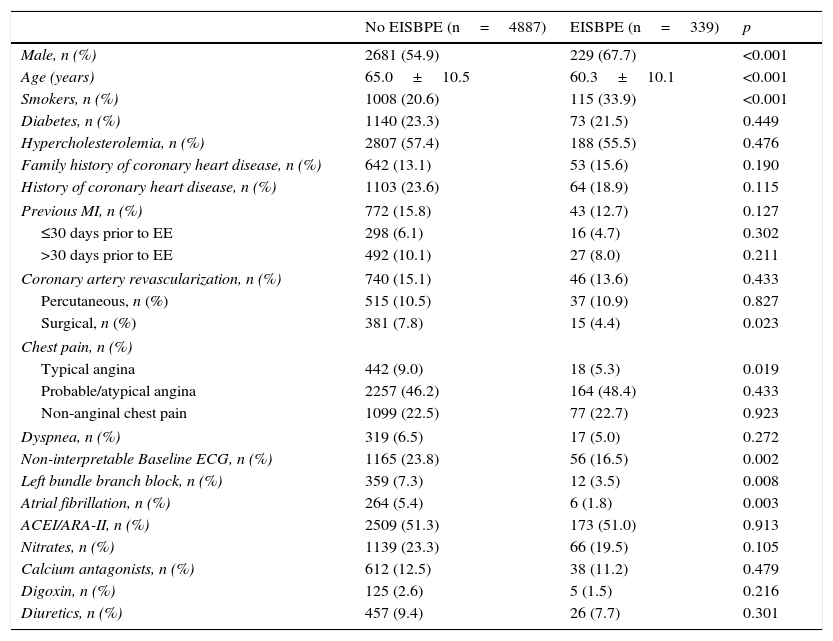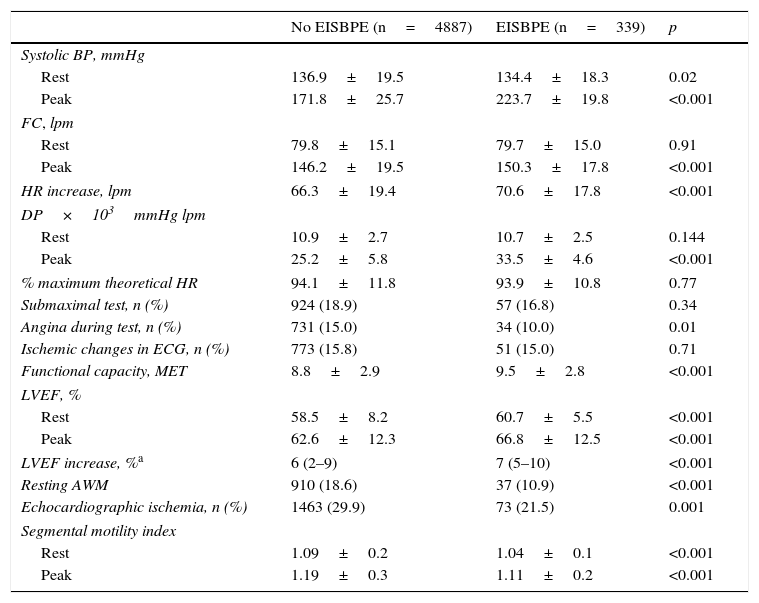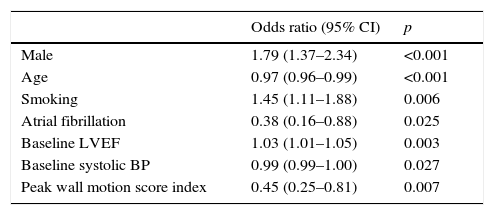The association of an exaggerated systolic blood pressure increase with exercise (EBPIE) with cardiovascular events remains controversial. Our aim was to determine the possible association of an EBPIE with survival and risk of serious cardiac events in patients with hypertension and known or suspected coronary artery disease (CAD).
Patients and methodsThis is a retrospective observational study based on a sample of 5226 patients with a history of arterial hypertension and known or suspected CAD referred for exercise echocardiography. The EBPIE was defined as an increase in systolic blood pressure with exercise greater than or equal to the 95th percentile of this population (80mmHg). The end points were all-cause mortality, cardiac death and myocardial infarction (MI).
ResultsDuring a mean follow-up of 4.7 years, there were 978 deaths (including 371 cardiac) and 798 MI. Annual rates of all-cause mortality, cardiac mortality and MI were 2.73, 0.83 and 2.63% in patients with EBPIE and 4.4, 1.58 and 3.98% in those without EBPIE (p<.001, p=.012, and p=.014, respectively). After multivariate analysis, an EBPIE remained independently associated with a lower risk of all-cause mortality (HR: 0.70, 95% CI: 0.52–0.95; p=.023) and MI (HR: 0.69, 95% CI: 0.50–0.95; p=.022) but was not significantly associated with cardiac mortality (HR: 0.72, 95% CI: 0.43–1.20; p=.2).
ConclusionsEBPIE was associated with an increased likelihood of survival and lower rate of MI in hypertensive patients with known or suspected CAD.
La asociación entre un incremento exagerado de la presión arterial sistólica con el ejercicio (IEPASE) y la probabilidad de eventos cardiovasculares es controvertida. Nuestro propósito fue determinar la posible asociación de un IEPASE con la supervivencia y con el riesgo de eventos cardíacos graves en pacientes hipertensos con enfermedad coronaria conocida o sospechada.
Pacientes y métodosSe trata de un estudio retrospectivo y observacional sobre una muestra de 5.226 pacientes con historia de hipertensión arterial y enfermedad coronaria conocida o sospechada referidos a ecocardiografía de ejercicio. El IEPASE se definió como un incremento de la presión arterial sistólica con el ejercicio igual o superior al percentil 95 de esta población (80mmHg). Los objetivos fueron mortalidad total, mortalidad de origen cardíaco e infarto de miocardio (IM).
ResultadosEn un seguimiento medio de 4,7 años, se registraron 978 muertes (371 de origen cardíaco) y 798 IM. Las tasas anuales de mortalidad, mortalidad de origen cardíaco e IM fueron del 2,73; 0,83 y 2,63% en pacientes con IEPASE y de 4,4; 1,58 y 3,98%, respectivamente en aquellos sin IEPASE (p<0,001; p=0,012 y p=0,014, respectivamente). Tras un ajuste multivariado, el IEPASE resultó predictor de mortalidad por cualquier causa (HR: 0,70; IC 95%: 0,52–0,95; p=0,023) e IM (HR: 0,69; IC 95%: 0,50–0,95; p=0,022), pero la asociación con mortalidad cardiaca no alcanzó significación estadística (HR: 0,72; IC 95%: 0,43–1,20; p=0,2).
ConclusionesEl IEPASE se asoció con mayor probabilidad de supervivencia y menor riesgo de IM en pacientes hipertensos con enfermedad coronaria conocida o sospechada.












